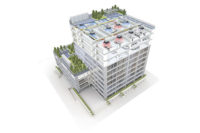I recently conducted a webinar about continuous insulation in exterior wall assemblies, a topic that has achieved white-hot status among design professionals of late. Due to (fairly) recent CI energy code requirements and adoption of said requirements by state and local jurisdictions, design professionals have found themselves a bit flat-footed in understanding how to get this into their buildings. There is a lot to know to be able to effectively and correctly wedge CI into all of the existing cladding systems commonly used on buildings. The webinar I conducted presented information about CI systems, types of insulation, attachment/fastening methods, and building and energy code compliance. It was a great success.
One question that came up after the webinar was presented stumped me: “Why wasn’t EIFS mentioned in the presentation?” I had no answer. It certainly wasn’t an intentional omission. Many of the basic ingredients of EIFS were shown and/or addressed during the webinar (insulation types, attachment methods, stucco, etc.) but the term “EIFS” never came up. As I thought about it, I came to the realization that EIFS, having been around for decades, the original CI system—if you will—did not come up in the webinar because it would have been stating the obvious. Indeed, the first two letters stand for Exterior Insulation. Equating EIFS with CI is like “Contents Are Hot!” on a coffee cup.
A SHORT HISTORY
EIFS was developed in Europe in the 1950s as a cladding system that could be installed over existing masonry walls that resulted in a dramatic improvement in energy efficiency while still retaining a “classic” monolithic appearance. EIFS was introduced in the United States during the oil crisis of the early/mid-1970s and was popular with energy-conscious owners or commercial buildings. The system gradually began to be used in the residential building sector, including single family housing. In the late-1990s, several lawsuits were brought against EIFS manufacturers and builders that installed the systems because of water ingress problems. The overwhelming majority of the leaks were the result of water intrusion through improperly prepared joints and penetrations. Problems ensued because this water was unable to escape, the systems having been installed predominately as face-sealed barrier systems with no means of escape provided. No cladding system installed in such a way, in a climate with significant annual precipitation, can be successful in the long run.
The water intrusion issues that plagued the EIFS industry in the 1990s are far behind us. EIFS manufacturers have been tireless in their educational efforts, showing designers, contractors and owners the many EIFS systems available, each thoroughly designed and tested for every conceivable climatic condition. Face-sealed barrier systems are used in areas with little to no annual precipitation, water-managed systems are available for areas with moderate annual precipitation, and fully pressure-equalized systems are available for areas with high amounts of annual rainfall. Each system has been designed with the appropriate combination of fastening methods, water management, and air/vapor/weather barrier coating materials.
IT’S EASY BEING GREEN
Attempting to quantify a cladding system’s sustainability can be a difficult task. What makes a cladding system green? Life Cycle Assessment is arguably the best way to size up one system to another but availability of systems’ LCAs is lacking. We are left with making a judgment call based on each material’s single attributes like recycled content, VOC emissions, embodied energy, etc. In sustainable-speak, less is greener. When comparing an EIFS to nearly any other cladding alternative, EIFS does more with less.
The difference between EIFS, with CI built into the system, and every other cladding system that incorporates CI is all the additional “stuff” that the other cladding systems need. EIFS uses the same rigid insulation types but instead of heavy materials applied over this material, using robust fasteners, clips, and anchors, EIFS instead incorporates a thin skin made of acrylic-based synthetic stucco and fiberglass mesh reinforcement. The entire system is lighter than any other cladding system, using far less material with much less total embodied energy.
Less is certainly greener but not enough by itself to make a cladding system truly sustainable. Energy efficiency and durability is also important. A building clad in EIFS automatically gets its CI stamp of approval—meeting both the energy code requirement and also the fire resistance requirement found in the International Building Code (EIF systems are what started the testing requirement for fire resistance of foam plastic insulations on buildings). EIFS also boasts superior air infiltration performance, a requirement that energy codes are likely to begin incorporating very soon (and some already have).
A recent study done by building enclosure scientists concluded that EIFS installed with a secondary water resistive air barrier “offers significant improvement in energy efficiency.” Durability is also vital to a system’s overall sustainability and EIFS is one of the most durable cladding systems available. In a widely distributed study, an EIFS mockup for a detention center in Greenville, S.C., was subjected to repeated sledgehammer blows and screw driver attacks—without failure. It is difficult for some to imagine this could be possible but seeing is believing: video documentation of the tests is available on the Whole Building Design Guide website (www.wbdg.org) under the heading “High Performance EIFS.” If seeing this video doesn’t convince you, nothing will.
CONCLUSION
EIFS is positioned for a huge comeback in buildings in the United States. Energy efficiency was the reason EIFS was first developed and this continues to be one of its greatest strengths. It is the grandfather of all continuous insulation systems, and offers superior air infiltration performance to boot. Not a fan of foamed plastic insulations? Not a problem with EIFS. Mineral wool board EIF systems are available—making this one of the hands down greenest cladding systems on the market. W&C





![WC0422-FEAT-ClarkDietrich-p1FT-CJ-EES[1].jpg WC0422-FEAT-ClarkDietrich-p1FT-CJ-EES[1].jpg](https://www.wconline.com/ext/resources/2022/04/12/WC0422-FEAT-ClarkDietrich-p1FT-CJ-EES%5b1%5d.jpg?height=200&t=1649794590&width=200)

Report Abusive Comment